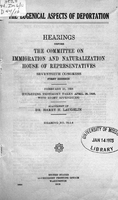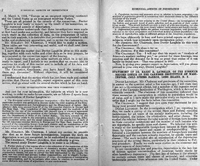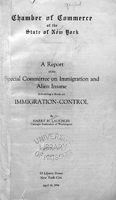Controlling Heredity
Eugenics and Immigration

Committee on Immigration and Naturalization, United States Congress
The Eugenical Aspects of Deportation: Hearings before the Committee on Immigration and Naturalization House of Representatives, Seventieth Congress, First Session February 21, 1928...Statement of Dr. Harry H. Laughlin.
Washington, D.C.: US Government Printing Office, 1928.
Government Documents Collection Y 4.Im 6/1:D 44/10
Ellis Library
University of Missouri Libraries
University of Missouri

Committee on Immigration and Naturalization, United States Congress
The Eugenical Aspects of Deportation: Hearings before the Committee on Immigration and Naturalization House of Representatives, Seventieth Congress, First Session February 21, 1928...Statement of Dr. Harry H. Laughlin.
Washington, D.C.: US Government Printing Office, 1928.
Government Documents Collection Y 4.Im 6/1:D 44/10
Ellis Library
University of Missouri Libraries
University of Missouri
Harry Laughlin had a driving interest in furthering eugenics in the United States through national immigration and naturalization policy.
Around 1922, Laughlin was designated as the “Expert Eugenics Agent” to the House Committee on Immigration and Naturalization chaired by Congressman Albert Johnson. Under Laughlin’s guidance the Committee recommended—and Congress passed—the Johnson-Reed Immigration Restriction Act of 1924. The law capped immigration quotas for all nations at low levels (2%) and especially slowed the migration of the foreign-born from places such as eastern and southern Europe (Russia, Poland, Italy, and the Balkans). According to Laughlin, the "unfit" and "insane" constituted an excessively large proportion of the national population in these regions. The act all but ended immigration from East Asia and the Indian Subcontinent.
On display is the testimony given by Laughlin to the House Committee in 1926 addressing the issue of further restricting the immigration rates. The Johnson-Reed Act provided that beginning July 1, 1927, the formula would no longer use a national percentage but revert to a flat number of immigrants to the United States, capped at 150,000. The change from 2% to 150,000 planned for 1927 was later postponed to July 1, 1929.

Harry Hamilton Laughlin (American, 1880 – 1943)
A Report of the Special Committee on Immigration and Alien Insane Submitting a Study on Immigration- Control.
New York: Chamber of Commerce of the State of New York, 1934.
Depository 325.73 L368r
University of Missouri Libraries
University of Missouri

Harry Hamilton Laughlin (American, 1880 – 1943)
A Report of the Special Committee on Immigration and Alien Insane Submitting a Study on Immigration- Control.
New York: Chamber of Commerce of the State of New York, 1934.
Depository 325.73 L368r
University of Missouri Libraries
University of Missouri
This report prepared by Laughlin for the New York State Chamber of Commerce in 1934, demonstrates his consistency and unwavering support of earlier Eugenics Record Office policies. At the time this report was written, total immigration into the United States was at the lowest level since reliable immigration statistics were first maintained in 1820.
In the years from 1931 to 1946, the total immigration into the United States was 50,500. Immigrants came in much greater numbers in the preceding and subseqent decades. The immigration rates per 1000 United States citizens were 0.4 in the period between 1931 and 1946 as opposed to 3.6 for the previous decade and 1.5 for the subsequent decade.
Immigration into the United States was at low-tide when the report was published; however, old guiding principles of the ERO were supported militantly regardless of the changing times or new trends.
On display is a table from an appendix to the report by Clairette Armstrong, Psychologist for the New York Children’s Court. The table shows the high percentage of New York school children from immigrant families who were in trouble or judged mentally impaired.